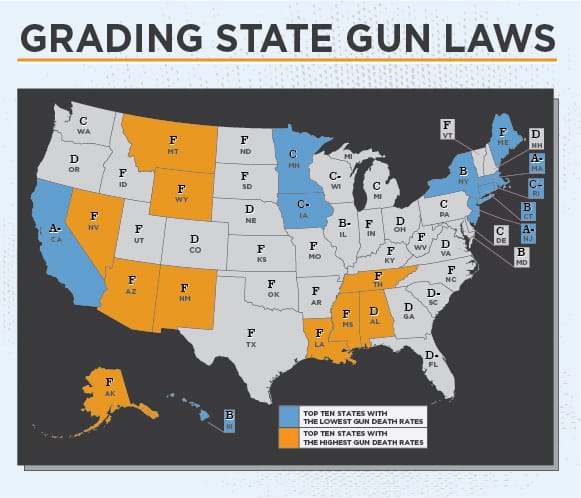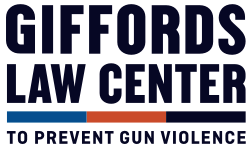
We hear stories of gun violence every day. Domestic disputes turning deadly. Street crimes taking the lives of innocent people. Mass shootings wreaking havoc in our public spaces. Suicides and fatal accidents devastating families across the country. The unrelenting toll of America’s gun violence epidemic leaves 100,000 people injured or killed every year in communities nationwide.1 But while the number of people affected by this crisis is staggering – 86 people die by guns every single day – it’s almost equally shocking to find that legislators nationwide aren’t doing everything in their power to prevent the killings.
Plenty of widely supported policies can reduce gun violence, but, in many states, they aren’t being adopted.2 In fact, a number of states have chosen to pass measures that actually make it more difficult for law enforcement, doctors, and local officials to work to reduce gun deaths and injuries.
State gun laws are critical because our federal gun laws are extremely weak and leave enormous gaps. For example, 40% of all gun sales can be completed without background checks because federal law doesn’t require checks for firearm sales between private parties.3 Unless states step in and adopt their own smart laws, federal gaps like these allow guns to easily flow into the hands of criminals.
Gun laws, however, vary widely from state to state. Some states, like California, have adopted a broad variety of important laws to prevent guns from falling into the wrong hands; many others, like Arizona and South Dakota, have adopted few or no good laws.
In our 2012 edition of Gun Laws Matter, we have ranked all fifty states based on 29 policy approaches to regulating firearms and ammunition.
States received points for having smart laws in each policy area, with stronger laws receiving more points. For example, states were awarded points if they have laws that:
- Require background checks on all firearm sales;
- Prohibit the sale of assault weapons and large capacity ammunition magazines; and
- Require law enforcement to evaluate an applicant’s alleged need before issuing a concealed handgun license.
States received negative points for having irresponsible measures that increase the likelihood of gun violence. These measures include:
- “Shoot First” laws, which gained national attention after the death of Trayvon Martin because they can prevent law enforcement from prosecuting shooters in public places;
- “Firearms Freedom Act” laws, which declare that federal gun laws do not apply to firearms manufactured and sold within a state’s borders; and
- Laws that prevent doctors from informing their patients about the health risks associated with firearm ownership.
Ultimately, every state was awarded a letter grade indicating the overall strength or weakness of its existing gun laws.

As we found two years ago in the first edition of this publication, states need to adopt strong gun laws because gun laws really do matter. Many of the states with the strongest gun laws also have the lowest gun death rates nationwide. Conversely, many states with the weakest gun laws have the highest gun death rates. While more research is needed to determine the precise relationship between state gun laws and gun death rates, the data supports the common sense conclusion that gun laws are a significant factor in a state’s rate of gun deaths.
Gun laws also matter beyond a state’s borders. Illegal gun traffickers often buy weapons in states with weak laws that end up recovered in crimes in other states. A report published by Mayors Against Illegal Guns (MAIG) found that states with a number of important gun laws had significantly lower rates of “crime gun exports” — where a firearm sold by a dealer in one state is later found at a crime scene in a different state — than states without these laws.4
MAIG identified a number of gun laws as key in the fight against illegal gun trafficking, including measures that:
- Require every person to acquire a permit to purchase a handgun;
- Require firearm owners to report lost or stolen firearms to law enforcement; and
- Require or allow law enforcement to inspect firearms dealers.
Moving Forward
The threat of gun violence does not have to be an inevitable fact of life in America. Because strong gun laws are clearly associated with lower rates of gun violence, legislators in every state should consider adopting a variety of smart policies that are widely supported by the American public. In every state, there is still much that can be done to prevent gun deaths, and many measures can have a positive impact well beyond a state’s borders. It’s not too late to prevent future tragedies.
- Nat’l Ctr. for Injury Prevention & Control, U.S. Centers for Disease Control and Prevention, Web-Based Injury Statistics Query & Reporting System (WISQARS) Injury Mortality Reports, 1999-2010, for National, Regional, and States; Nat’l Ctr. for Injury Prevention & Control, U.S. Centers for Disease Control and Prevention, Web-Based Injury Statistics Query & Reporting System (WISQARS) Nonfatal Injury Reports.[↩]
- For model legislation on a number of critical gun violence prevention polices, see our publication Model Laws for a Safer America.[↩]
- Philip J. Cook & Jens Ludwig, Guns in America: National Survey on Private Ownership and Use of Firearms, U.S. Department of Justice, National Institute of Justice Research in Brief 6-7 (May 1997). See our Federal Law on Private Sales page for more information.[↩]
- Mayors Against Illegal Guns, Trace the Guns: The Link between Gun Laws and Interstate Gun Trafficking 2-3, 29 (Sept. 2010).[↩]
